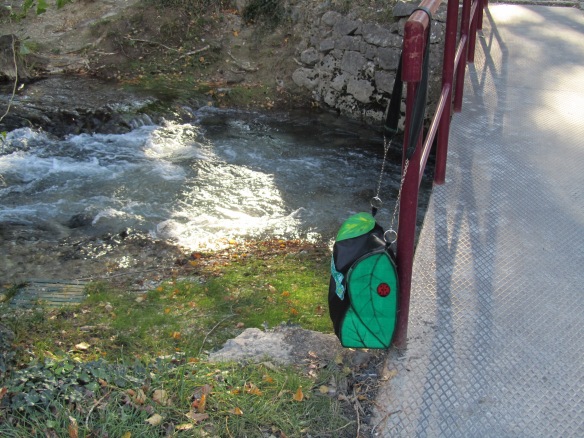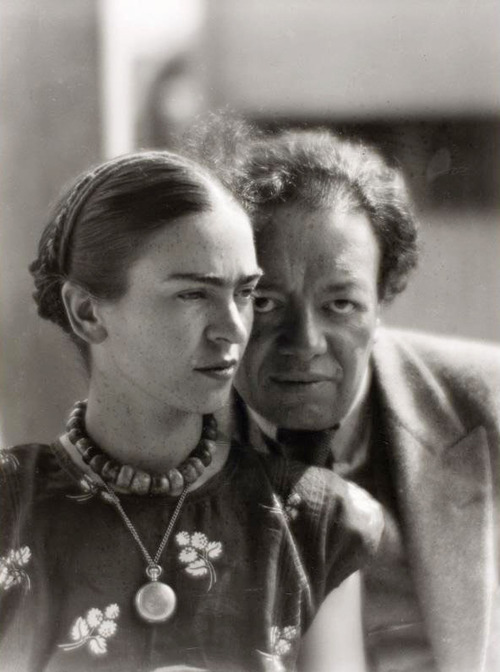Frida Kahlo, the famous Mexican painter, was truly a definition of an empovered, beautiful, and a unique woman. She lived a life which consisted of many ups and downs, life of constant pain, enormous talent, and a will to live to the fullest. In her paintings she prefered a lot of patterns and colors, and her own personal style reflected that. Flowers in her hair, big golden earrings and necklaces, long ruffled skirts and her trademark unibrow made her a person to remember and admire. Today her self-portraits and paintings are widely recognised, and she is a constant inspiration to fashion designers.
I deeply admire her, and I love her work, her strength, and her fantastic fashion sense. I possess a lot of jewelry, but I often end up with one of my favourite pairs of earrings – a picture of Frida’s self-portrait with a thorn necklace and a hummingbird. When I put them on, I feel womanly, strong, and proud at the same time.
Frida Kahlo : Self-portrait with a thorn necklace and a hummingbird
Illegale Frida earrings
Arka Hand Made wool tunic dress
Leather belt from the 70s – it once belonged to my mother
Arka Hand Made wood and leather hand painted bag
Desigual ankle boots
Frida Kahlo (1907-1954), a Mexican painter, was one of four daughters born to a Hungarian-Jewish father and a mother of Spanish and Mexican Indian descent, in the Mexico City suburb of Coyoacan.
Frida as a child
She did not originally plan to become an artist. A polio survivor, at 15 Kahlo entered the premedical program at the National Preparatory School in Mexico City. However this training ended three years later when Khalo was gravely hurt in a bus accident.
 Young Frida before a bus accident – dressed as a man
Young Frida before a bus accident – dressed as a man
She spent over a a year in bed, recovering from the fractures of her back, collarbone, and ribs, as well as a shattered pelvis and shoulder and foot injuries. Despite more than 30 subsequent operations, Kahlo spent the rest of her life in constant pain, finally succumbing to related complications at age 47.
Frida Kahlo : The Broken Column
While Frida Kahlo was confined to her bed, her mother brought her a small lap easel, and Frida started to paint. She had a mirror over her bed so she could see herself, and this was the beginning of her focus on self-portraits.
Frida Kahlo – The Two Fridas
Frida Kahlo – Roots
When she died, her husband Diego Rivera ordered for her clothes to be locked up for 15 years. When Diego passed three years later, an old friend of the couple, Dolores Olmedo, became the manager of their houses. She kept all of Kahlo’s belongings secretly guarded under lock and key for decades, until she too passed away in 2004, and the fashion time capsule of an icon, a treasure chest, was finally unlocked.
 Frida and her husband, Mexican painter Diego Rivera
Frida and her husband, Mexican painter Diego Rivera
Defiantly beautiful, Frida Kahlo was and still is one of the most revolutionary and influential women in modern culture. The Mexican artist, known for her surreal self-portraits, emblematic of her indigenous Mexican culture, is known for her great love for her husband and her tragic disability.
Frida used the long skirts and corsets to hide a body which was left disfigured by childhood polio and a near-fatal road accident when she was 18, including a leg amputation in her last years.
Beautiful Frida
Despite being passionate and deep, Frida’s and her husband Diego’s love for each other was so often troubled. They both had terrible tempers and entertained many extramarital affairs. The artist never tried to hide the great deal of pain she experienced in her life. Her often violent, sinister self-portraits and paintings always portrayed exactly what Frida was experiencing in her life.
Frida Kahlo – Tejuana self portrait
So many people ask why Frida kept her monobrow and facial hair. Because of her disabilities, Frida spent so much time alone in isolation and meditation, studying herself, mastering the fear of being alone and seeing the beauty in herself. She once said in an interview, “I paint myself because I am so often alone and because I am the subject I know best.”
The women on the cocktail circuit of the late 1930s all wore curve-hugging dresses, but not Frida Kahlo. Frida had more individual wardrobe tastes, accessorised with ribbons, full skirts and loose peasant blouses embroidered with vividly colored flowers.
Frida in her Tejuana shirt, wearing her golden necklace and earrings
Exhibition of Frida’s wardrobe in Mexico City
Her clothing was used to disguise a life of pain, both physical and emotional. Her long, full skirts hid a tiny, thin right leg, and loose blouses covered the stiff corsets she wore for back pain. She described how she used her clothes to cover her body imperfections.
 Fashion designers and photographers have been captivated by Kahlo and have put together numerous collections in her honor.
Fashion designers and photographers have been captivated by Kahlo and have put together numerous collections in her honor.
Dolce and Gabanna 2010
Many of Kahlo’s blouses were custom made. She bought the fabrics and took them to Indian seamstresses. Some were made of velvet cherry, the fabric often used for traditional elegant dresses in Oaxaca region known as the Isthmus of Tehuantepec.
The Tejuana dress, named after Indian women of that region, was Kahlo’s signature piece of clothing. She wore it with large gold earrings and flowers in her braided hair. It is not a dress she chose by accident. The women run that society and symbolize power.
The dress became her signature look in her many self-portraits – copied by women worldwide.
 Portrayed by Salma Hayek in 2002 movie “Frida”
Portrayed by Salma Hayek in 2002 movie “Frida”
Frida soundtrack – El Antifaz
Pics by Miss Stela and Miss Nina








































![fridakahlo22[1]](https://missdeestyle.files.wordpress.com/2013/12/fridakahlo221.jpg?w=584)

Pingback: Happy First Birthday “Miss Dee STyle” Blog :) ! | Miss Dee STyle
Pingback: Shoe Gal | Miss Dee STyle